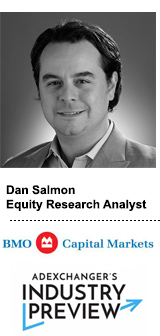 Dan Salmon will speak at AdExchanger’s upcoming Industry Preview conference on Jan. 17-18, 2018, at the Grand Hyatt New York.
Dan Salmon will speak at AdExchanger’s upcoming Industry Preview conference on Jan. 17-18, 2018, at the Grand Hyatt New York.
As 2018 kicks off, markets are wary of ad-driven stocks – unless your name is Alphabet, Facebook or Amazon. But there remains immense value in companies enabling addressable audiences, according to Dan Salmon, equity research analyst for BMO Capital Markets.
AdExchanger spoke with Salmon about his view of the advertising landscape in 2018, and the data that will power growth this year.
AdExchanger: You cite ecommerce data as a major ad revenue growth driver. How much of those gains go to Amazon, and is that trend good for brick-and-mortar retailers as well?
DAN SALMON: It’s not driven solely by Amazon. But the opportunity in advertising correlates well with the level of commerce, and Amazon has a substantial amount. EBay is also benefiting and so too are legacy brick-and-mortar retailers like Walmart, Target and Kroger. And companies like the former HookLogic (acquired by Criteo) and WPP’s Triad Retail Media support dozens of other retailers in this area.
The focus of our work lately has been on ecommerce and online advertising, but this is really an extrapolation of our view that the addressable market for online advertising is twice as large as most people believe, once one adds offline direct marketing, and – most relevant to this question – trade promotion, i.e., the money that has been paid for decades by fast-moving consumer goods companies to retailers for better shelf space, price reductions and promotions.
How has regulatory uncertainty around media and telco mergers affected your forecasts?
Regulatory uncertainty hasn’t had much of an impact on our forecasts for the media companies, but it does cloud the outlook for their stocks. In the US, much of this stems from the DOJ’s lawsuit to prevent AT&T’s acquisition of Time Warner, a vertical integration (of a distributor and supplier) that prior precedent (like Comcast’s acquisition of NBC Universal) suggested would not face major objections.
21st Century Fox’s proposed acquisition of the 61% of Europe’s Sky that it doesn’t already own has also come under further review this year as well. And that was before the proposed transaction with Disney, which will face its own regulatory process. To be fair, several deals, including Discovery’s acquisition of Scripps Interactive, remain on track.
What are the key factors you’ll be watching in the TV landscape?
The newer things are whether M&A of established players (AT&T + Time Warner, Disney + Fox) is allowed to proceed, and how much more YouTube/Google and Facebook commit to premium content, and whether or not that licensing spending/ad revenue sharing will begin to look more like the billions that Amazon and Netflix spend on premium content.
The things that will remain the same include the growth of over-the-top viewership (and decline of linear), traction of addressable TV advertising and innovations in measurement, among other things.
It’s been a down year for the big holding company stocks – do you think that continues? To what degree do you see this as a cyclical trend versus a more long-term change in agency valuations?
I think there are cyclical elements; for example, I don’t expect the pressure from consumer packaged goods companies to persist at this level forever. There are also many real changes, like competition at the edges (if not the core businesses) from IT services and consultancies. But there has always been change, and the holding companies are constantly evolving too.
What is your current outlook for Twitter? What are the factors liable to help or hinder its progress?
I like what they’ve done with live content; it meshes well with their foundation as an open, real-time platform. Like others, they face questions on the role of such open platforms in modern society due to the questions raised by political events like Brexit and the 2016 US elections.
With so much attention on factors like these, I think an overlooked one that will be very important for success (or not) is what Twitter can do to improve as a direct-response advertising medium. That is the high-margin revenue that has been the bedrock of successful online advertising businesses.
Do you foresee any sea changes in how marketers “rationalize” ad spend in the coming year?
Beyond our belief that that most are still underappreciating the opportunity for ecommerce sites to build their ad revenues, I don’t think we see any sea changes, but rather plenty more incremental change. I think voice-enabled devices have driven interest in audio advertising, and that is one of the top emerging trends we’re watching.
This post was syndicated from Ad Exchanger.

More Stories
The IAB Predicts Social Video Will Overtake CTV This Year
Best Buy and CNET Are Combining Their Ad Inventory
Buyers Are Wasting Money on Alt IDs While Cookies Still Persist